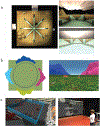Studying the Development of Navigation Using Virtual Environments
- PMID: 37614812
- PMCID: PMC10445272
- DOI: 10.1080/15248372.2022.2133123
Studying the Development of Navigation Using Virtual Environments
Abstract
Research on spatial navigation is essential to understanding how mobile species adapt to their environments. Such research increasingly uses virtual environments (VEs) because, although VE has drawbacks, it allows for standardization of procedures, precision in measuring behaviors, ease in introducing variation, and cross-investigator comparability. Developmental researchers have used a wide range of VE testing methods, including desktop computers, gaming consoles, virtual reality, and phone applications. We survey the paradigms to guide researchers' choices, organizing them by their characteristics using a framework proposed by Girard (2022) in which navigation is reactive or deliberative, and may be tied to sensory input or not. This organization highlights what representations each paradigm indicates. VE tools have enriched our picture of the development of navigation, but much research remains to be done, e.g., determining retest reliability, comparing performance on different paradigms, validating performance against real-world behavior and open sharing. Reliable and valid assessments available on open-science repositories are essential for work on the development of navigation, its neural bases, and its implications for other cognitive domains.
Conflict of interest statement
Disclosure statement No potential conflict of interest was reported by the author(s).
Figures



Similar articles
-
Perspective: Assessing the Flexible Acquisition, Integration, and Deployment of Human Spatial Representations and Information.Front Hum Neurosci. 2018 Jul 11;12:281. doi: 10.3389/fnhum.2018.00281. eCollection 2018. Front Hum Neurosci. 2018. PMID: 30050422 Free PMC article.
-
Exploring the Spatial Relationships Between Real and Virtual Experiences: What Transfers and What Doesn't.Front Virtual Real. 2020 Oct;1:572122. doi: 10.3389/frvir.2020.572122. Epub 2020 Oct 8. Front Virtual Real. 2020. PMID: 37885756 Free PMC article.
-
Virtual Reality for Spatial Navigation.Curr Top Behav Neurosci. 2023;65:103-129. doi: 10.1007/7854_2022_403. Curr Top Behav Neurosci. 2023. PMID: 36512288
-
The potential of virtual reality for spatial navigation research across the adult lifespan.J Exp Biol. 2019 Feb 6;222(Pt Suppl 1):jeb187252. doi: 10.1242/jeb.187252. J Exp Biol. 2019. PMID: 30728232 Review.
-
Learning and transfer of complex motor skills in virtual reality: a perspective review.J Neuroeng Rehabil. 2019 Oct 18;16(1):121. doi: 10.1186/s12984-019-0587-8. J Neuroeng Rehabil. 2019. PMID: 31627755 Free PMC article. Review.
Cited by
-
Do spatial navigation and episodic memory rely on the same systems? Evidence from a naturalistic experience with children and adults.J Exp Psychol Gen. 2025 Jul 10:10.1037/xge0001805. doi: 10.1037/xge0001805. Online ahead of print. J Exp Psychol Gen. 2025. PMID: 40638310
-
My Tablet's About to Go Dead! 5- to 6-year-old Children Adjust Their Cognitive Strategies Depending on Whether An External Resource is Reliably Available.Cogn Dev. 2025 Jan-Mar;73:101542. doi: 10.1016/j.cogdev.2025.101542. Epub 2025 Jan 8. Cogn Dev. 2025. PMID: 39830083
-
Virtual Reality and Serious Videogame-Based Instruments for Assessing Spatial Navigation in Alzheimer's Disease: A Systematic Review of Psychometric Properties.Neuropsychol Rev. 2025 Mar;35(1):77-101. doi: 10.1007/s11065-024-09633-7. Epub 2024 Feb 26. Neuropsychol Rev. 2025. PMID: 38403731 Free PMC article.
-
How Can We Best Assess Spatial Skills? Practical and Conceptual Challenges.J Intell. 2024 Jan 16;12(1):8. doi: 10.3390/jintelligence12010008. J Intell. 2024. PMID: 38248906 Free PMC article. Review.
References
-
- Anooshian LJ, & Young D (1981). Developmental changes in cognitive maps of a familiar neighborhood. Child Development, 52(1), 341. doi:10.2307/1129248 - DOI
-
- Balcomb F, Newcombe NS, & Ferrara K (2011). Finding where and saying where: Developmental relationships between place learning and language in the first year. Journal of Cognition and Development, 12(3), 315–331. doi:10.1080/15248372.2010.544692 - DOI
-
- Bécu M, Sheynikhovich D, Ramanoël S, Tatur G, Ozier-Lafontaine A, Sahel JA, & Arleo A (2020). Modulation of spatial cue processing across the lifespan: A geometric polarization of space restores allocentric navigation strategies in children and older adults. BioRxiv. doi:10.1101/2020.02.12.945808 - DOI
Grants and funding
LinkOut - more resources
Full Text Sources
